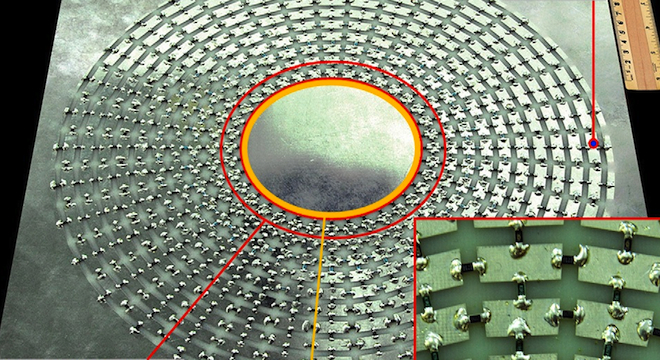Optical invisibility cloaks — those that make objects undetectable to the human eye — are still the stuff of science fiction. But scientists are getting closer every day: The latest advance in cloaking comes out of China, where scientists at Southeast University in Nanjing have developed a “nearly perfect” cloaking device for hiding DC current, a building block toward optical invisibility.
The “nearly perfect” DC cloak is also ultrathin — only 1 cm thick, which is the absolute limit for thinness of this type of practical demonstration, according to an article published on the advance on PhysOrg on Thursday. The original results of the demonstration were published in the journal Applied Physics Letters on January 10.
The cloak that the Chinese researchers successfully tested was made up of a network of resistors, common parts of electrical circuits that are used to reduce voltage, which act in this case as a type of metamaterial, an artificial material that exhibits properties such as bending current or electromagnetic waves, including visible light.
However, the cloak in this case doesn’t affect visible light, instead just hides the static fields produced by direct current and magnetic fields, as PhysOrg reported.
Still, it could soon lead to the development of an optical cloak, because visible light is made up of electrical and magnetic parts.
The DC electric cloak, despite being very thin, also has a relatively large area — taking up a circle about 11 inches (30 centimeters) in diameter, according to a photo of the cloak included in the journal article (top). That limits its practical usage somewhat, for now.
But researchers suggested that even in its current form, their cloak could have some practical applications, such as concealing landmines and torpedos.
“Knowing the physical principle, we may also find ways to detect the cloaked landmines,” lead researcher Tie Jun Cui told PhysOrg.
Cui and some of his fellow researchers previously achieved the first experimental demonstration of a DC cloak as reported in a paper published in April 2012, at which point that offered other practical applications including: “natural resource exploration, and military camouflage.”
The research was funded by the Chinese government.
Separately, in the U.S., other work has already been carried out on microwave cloaking at the University of Texas in Austin and on limited optical cloaking, or the “mirage effect,” using carbon nanotubes at the University of Texas in Dallas. Much of the current work in cloaking is centered around a concept known as “transformation optics,” which involves warping space to bend light around objects.






